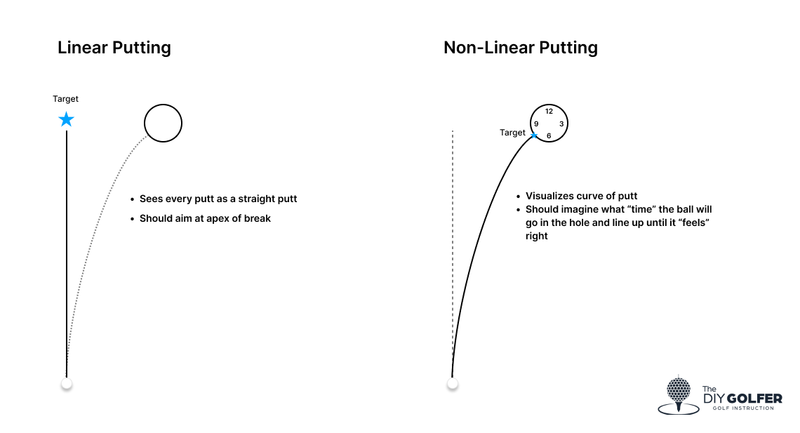This week, I want to share 3 putting tips you've never heard of and why they might just transform your game inside 50 feet.
Tip #1: Are you a linear or non-linear green reader?
Did you know that some golfers see the break of putts completely differently than you?
Some golfers putt in straight lines while others prefer to "putt to the curve".
Let's look at an example.
Imagine you have a left-to-right breaking putt and your playing partner says to you, "I think it's about 3 balls outside the left edge" and points to a "spot" on the green.
A "linear" putter will aim directly at that spot just fine.
A "non-linear" putter will attempt to aim at that spot, but in reality, they are aiming left of that spot to compensate for the break.

In short, here are some guidelines for each style:
- Linear putters - you are best off picking a "spot", aiming directly at it, and imagining your putt moving in a straight line.
- Non-Linear putters - rather than aiming at a "spot", try looking directly at the hole and imagining it as a clock. What "time" will the ball go in at? Aim there and watch as your body naturally figures out the "spot" without even trying. Imagine the ball rolling along a curve.
Not sure which one you are? Check out my full post on linear vs. non-linear putters.
Tip #2: Do you use a pendulum or "push" stroke?
You've probably heard the advice, "swing your putter like a pendulum" or "rock your shoulders back and forth".
This is great advice...
For golfers who place the ball in the center of their stance while putting. A classic example of this is Tiger's stroke:
But if you prefer to place the ball forward in your stance and "push" your putts, using the "pendulum" motion won't work too well for you. Instead, your stroke should have a short backstroke and longer follow-through, characteristic of the Dave Stockton putting method:
Let's be clear about something—neither stroke is bad.
You just need to know what type of stroke you're using and stop listening to advice that doesn't apply to your style.
In summary:
- Ball center of stance - your stroke should be a "pendulum" where the backstroke and follow-through are perfectly symmetrical
- Ball forward in stance - your stroke should be a 25/75 stroke where the backstroke is 25% and the follow-through is 75% with a flat lead wrist held through impact
Tip #3: Putt with one eye closed
Here's one of my favorites.
Would you believe me if I said I've played hundreds of golf tournament rounds keeping my left eye closed on all my short putts?
If you struggle to keep your head down and can't seem to make those 3-10 footers, try it out.
By closing your lead eye, you'll feel less inclined to "peek" at whether the ball went in or not and will make much better putting strokes.
Concluding thoughts
While ripping a drive straight down the middle is often more satisfying than holing a 10-footer for par, I'd argue that for most amateur golfers, the biggest opportunity to drop strokes quickly is on the putting green.
How does an 87 sound vs. a 91? How about a 99 vs. 103? Or a 79 vs. 82?
In any given round, making just 1-2 extra putts can mean the difference between "just another round" and "my best round yet!".
And with that, I'll see you in the next issue!
Hit 'em straight!
